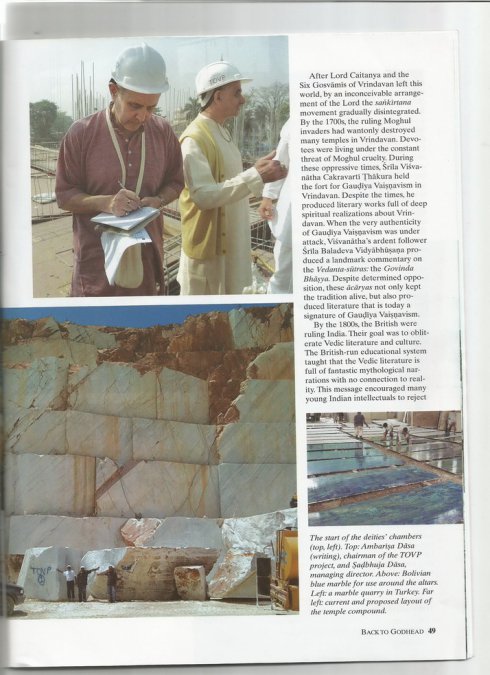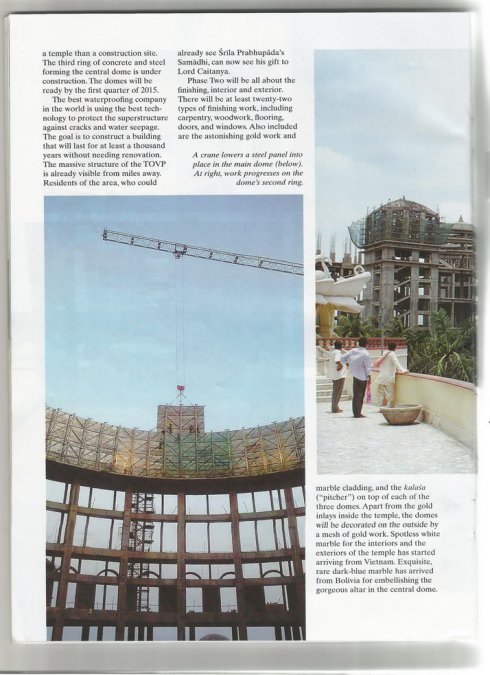TOVP The Future in The Making
Metaphorically, prominent acaryas in Lord Caitanya’s line laid the foundation for the Temple of the Vedic Planetariumby Ajita Nimai Dasa
The construction of the Temple of the Vedic Planetarium (TOVP) – the biggest Vedic temple in the world – is well underway in the holy town of Mayapur, West Bengal. Lord Sri Caitanya Mahaprabhu, who is Sri Krsna Himself in the role of His own devotee, appeared in Mayapur in 1486 CE and inaugurated the sankirtana movement of the congregational chanting of God’s names.
His movement has since spread all over the world through the unyielding dedication of His devotees. The most notable recent devotee was His Divine Grace A. C. Bhaktivedanta Swami Prabhupada. While the movement he founded, the International Society for Krishna Consciousness (ISKCON), continues to expand the sankirtana movement’s enlightening influence in various ways, the TOVP is its biggest construction project today.
The Future Rests on the Past
The TOVP is far from complete, and the same can be said of the astronomical mission of the sankirtana movement. But their current state points to a magnificent future for both. The future rests on the past, and deep appreciation of the past Vedic culture can inspire a stupendous future for Vedic projects today. The Vedic literature asserts that the Vedic tradition is not only old, but timeless. When introducing to Arjuna the topic of transcendental knowledge, Lord Krsna tells him:
imam vivasvate yogam
proktavan aham avyayam
vivasviin manave priiha
manur iksviikave ‘bravit
“I instructed this imperishable science of yoga to the sun-god, Vivasvan, and Vivasvan instructed it to Manu, the father of mankind, and Manu in turn instructed it to Iksvaku.” (BG 4.1)
Srila Prabhupada writes in his purport that this knowledge has been extant in human society for at least two million years. The sacred system of parampara (disciplic succession) keeps the knowledge flowing from one generation to the next. But this current of spirituality must not be taken for granted. Its carriers at any time in history are always up against the opposing undercurrent of materialism that characterizes the material world. Time and again this untiring, sinister current sidelines the spiritual current and becomes prominent in the world, creating tough times for the bearers of the parampara system.
To set things right, sometimes Krsna descends to reveal spiritual knowledge. About five thousand years ago He spoke the Gita to Arjuna in the dramatic setting of a world war
sa eviiyam maya te ‘dya
yogan proktali puriitanah.
bhakto ‘si me sakhd ceti rahasyam
hy etad uttamam
“[Because it has been lost in the course of time,] that very ancient science of the relationship with the Supreme is today told by Me to you because you are My devotee as well as My friend and can therefore understand the transcendental mystery of this science.”(BG 4.3)
And then five hundred years ago Lord Caitanya revealed the same knowledge once again by teaching and exemplifying the practical message of devotion. At other times, the acaryas, prominent links in the parampara chain, keep the message alive and distribute it profusely. The TOVP is a tribute to the glorious acaryas of Lord Caitanya’s Gaudiya Vaisnava parampara.
It’s not easy to keep a flame burning in turbulent winds. It’s tougher still to light more lamps in the process. While all links in the parampara are praiseworthy, those who operate in turbulent anti-spiritual times to create a blazing spiritual movement are extra special.
After Lord Caitanya and the Six Gosvamis of Vrindavan left this world, by an inconceivable arrangement of the Lord the sankirtana movement gradually disintegrated. By the 1700s, the ruling Moghul invaders had wantonly destroyed many temples in Vrindavan. Devotees were living under the constant threat of Moghul cruelty. During these oppressive times, Srila Visvanatha Cakravarti Thakura held the fort for Gaudiya Vaisnavism in Vrindavan. Despite the times, he produced literary works full of deep spiritual realizations about Vrindavan. When the very authenticity of Gaudiya Vaisnavism was under attack, Visvanatha’s ardent follower Srila Baladeva Vidyabhusana produced a landmark commentary on the Vedanta-satras: the Govinda Bhiisya: Despite determined opposition, these acaryas not only kept the tradition alive, but also produced literature that is today a signature of Gaudiya Vaisnavism.
By the 1800s, the British were ruling India. Their goal was to obliterate Vedic literature and culture. The British-run educational system taught that the Vedic literature is full of fantastic mythological narrations with no connection to reality. This message encouraged many young Indian intellectuals to reject Vedic schools of thought, including Gaudiya Vaisnavism, then in a pathetic state. Many groups proclaiming to be Gaudiya Vaisnavas had cropped up. But their behavior and philosophical understanding were far removed from the pure teachings of Lord Caitanya. Like the mud-born lotus, amidst such harsh, filthy, anti-spiritual circumstances appeared Srlla Bhaktivinoda Thakura. He struggled hard against the strong opposing currents to establish the pure original teachings of Gaudiya Vaisnavism.
He wrote extensively, preached door-to-door in villages, and published authentic philosophical works of the Six Gosvamis. His son Srila Bhaktisiddhanta Sarasvati Thakura carried forward his father’s mission with fiery zeal, establishing sixty-four Gaudiya Matha temples all over India. His foremost disciple, Srila A. C. Bhaktivedanta Swami Prabhupada, established ISKCON. Volumes of books describe his monumental life and spectacular success. But we must not forget the hardships he underwent to serve his spiritual master and Lord Caitanya, driven by his compassion for us.
If we deeply appreciate what these exalted acaryas have done for Krishna, the world, and us, we will always worship them within our hearts with gratitude and affection. The TOVP will express these highly elevated spiritual feelings by placing fifteen acaryas – from the Six Gosvamis to Srila Prabhupada – on the main altar. This will be the first time in Gaudiya Vaisnava history that so many past acaryas reside on the main altar of a temple. Dedicated artists are using the latest technology and careful research to create lifelike deities portraying the mood and personality of each acarya. Unlike the Lord, who can accomplish everything effortlessly, these acaryas toiled unimaginably hard. They used their spiritual acumen while depending on the Lord’s mercy alone. They accomplished what is ordinarily impossible. The TOVP is a salute to their sacrifices and contributions. Indeed, the TOOVP and the sankirtana mission are growing all over the world on the philosophical, institutional, literary, and cultural foundation they laid.
Taking Shape
Phase One of the TOVP construction is near completion. It consists of the RCC (reinforced cement concrete) framework of columns, the brickwork, and the massive domes that will be the most striking feature of the temple. The RCC framework is complete. The spaces are now well defined, the structure’s immensity apparent. The brickwork is defining the edges of the building, which has started looking more like a temple than a construction site. The third ring of concrete and steel forming the central dome is under construction. The domes will be ready by the first quarter of 2015.
The best waterproofing company in the world is using the best technology to protect the superstructure against cracks and water seepage. The goal is to construct a building that will last for at least a thousand years without needing renovation. The massive structure of the TOVP is already visible from miles away. Residents of the area, who could already see Srila Prabhupada’s Samadhi, can now see his gift to Lord Caitanya.
Phase Two will be all about the finishing, interior and exterior. There will be at least twenty-two types of finishing work, including carpentry, woodwork, flooring, doors, and windows. Also included are the astonishing gold work and marble cladding, and the kalasa (“pitcher”) on top of each of the three domes. Apart from the gold inlays inside the temple, the domes will be decorated on the outside by a mesh of gold work. Spotless white marble for the interiors and the exteriors of the temple has started arriving from Vietnam. Exquisite, rare dark-blue marble has arrived from Bolivia for embellishing the gorgeous altar in the central dome.
Work has started on the design of the kalasa, which symbolizes abundance, growth, and new life. The kalasa on top of the central dome will be four stories (sixty-eight feet) tall. It will be coated with the extremely hard ceramic material known as titanium nitride (TiN), which looks like gold, lasts very long, and will make the kalasa maintenance free.
A team of artists considers every detail of the various aspects of the design. Each component gets pains-taking attention before getting finalized. The temple site is clean. The construction work is of the highest quality, ensured not only by strict monitoring of the work but also by inspiring the workers. Recently all the workers attended a class on the importance and significance of the project.
From the top of the central dome will hang the world’s largest chandelier, one of Srila Prabhupada’s most cherished ideas for the temple. It will depict the structure of the universe as described in the Shrimad-Bhagavatam, as well as the spiritual world beyond, up to the highest spiritual planet, Goloka Vrndavana. Visitors will be able to study the universe from multiple levels. Galleries and exhibits at each level will explain the purpose of the universe and its various aspects. The highest level will take visitors on a tour of the spiritual world.
Prabhupada’s Desire Srila Prabhupada used to say that Bombay was his office, Vrindavan his home, and Mayapur his place of worship. On Lord Caitanya’s order, the Six Gosvamis discovered and excavated many holy places in Vrindavan, Krsna’s town. Similarly, recent Gaudiya acaryas contributed immensely to Mayapur, Lord Caitanya’s town. Srila Bhaktivinoda Thakura discovered Lord Caitanya’s birthplace. Srila Bhaktisiddhanta Sarasvati Thakura discovered many pastime places of Lord Caitanya and founded the Gaudiya Matha, with a prominent branch – the Sri Caitanya Matha – in Mayapur. Similarly, the TOVP will be Srila Prabhupada’s most striking contribution to Mayapur, his place of worship.
Centuries ago, devoted kings built grand temples. For example, the massive temple of Ranganath Swamy (a reclining form of Lord Visnu) in Trichy, Tamil Nadu, was built between the eleventh and seventeenth centuries CEo During this period, the rulers of the region changed, but all of them gave paramount importance to the temple’s construction. Times have changed. The rulers of the India don’t build temples anymore. Temples are now built by raising funds from the public. Mayapur is the international headquarters of ISKCON. Consequently, the TOVP is not a local temple of Mayapur or even India. Due the interconnected nature of modern times, and the international outreach of Srila Prabhupada’s ISKCON, the TOVP is an international temple for the entire population of the earth.
Srila Prabhupada taught his followers to desire big for the service of Krsna. The TOVP was one of Srila Prabhupada’s grandest desires. The desires of pure devotees are fulfilled by the Lord Himself. For example, years before Srila Prabhupada started ISKCON he had a desire to build a grand temple in Juhu, Bombay. Years later the landmark Sri Sri Radha-Rasabihari Temple manifested. The TOVP team would like to move the deities – the Pancha Tattva, Sri Sri Radha-Madhava and the Eight Gopis, and Lord Nrsimhadeva – into the TOVP by 2022. When devotees of the Lord come together and cooperate in the spirit of gratitude and love, anything is possible.










